In Pocahontas II: Journey to a New World, Pocahontas voyages to England with John Rolfe, an English diplomat. She must stop the villainous Governor Ratcliffe’s manipulation of King James and prevent the King from declaring war on the Native Americans. As expected in a Disney film, she just happens to fall in love with Rolfe while she’s at it. A tribesman named Uttamatomakkin accompanies her to England, as do her trusty animal sidekicks: Flit the hummingbird, Meeko the racoon and Percy the pug. She also meets new animals whilst in London, including an unnamed captured bear. This bear is always restrained and is subject to torture at the hands of humans. The presence of this bear comes to represent wider issues regarding the exploitation of animals for human entertainment as well as acting as a cultural symbol for political human issues.
Pocahontas II is an animated children’s film. As such, the animals are animated in a way which appeals to and resonates with children. Desmond Morris discusses such resonation, referring to a study in which children were asked which animals they liked the most. Bears made the top ten and he attributes this to their humanoid features including their facial expressions and vertical body.[1] The bear in Pocahontas II embodies both of these features but as these come naturally to the bear, they are not anthropomorphised in the same way as Meeko and Percy, who are given human-like personalities. The bear is therefore able to represent both humans and animals simultaneously. Their human-like qualities make the bear easier for children to empathise with but leaving the bear with their natural animality allows for sympathy to be applied to real bears too. The film is also loosely based on historical events in that Pocahontas did travel to London, there was colonial conflict between the English and Native Americans and dancing bears and bearbaiting were a real thing. This historicism links to Paul Wells’ statement that, ‘Though Disney narratives […] necessarily addressed a family audience and incorporated a flux of complex and mature incidents and themes, the main intention was to entertain and educate children’.[2] The film has an element of education (or at least exposure) in terms of animal welfare issues and deeper analysis reveals how ‘mature themes’ such as colonial conflict are portrayed through animals in order to educate children on such topics whilst remaining subjectively family-friendly or uncontroversial. The artistic form of animation is distanced from reality in comparison to live action films and thus, violence can be included without exposing young audiences to seemingly real violence. Overall, the genre and characteristic elements of Pocahontas II work towards representing the bear in a way which allows them to be symbolic of both animal and human issues and expose children to deeper issues in an understandable yet U-certified way.

their hind legs,
seemingly smiling

bear on their hind legs
with a displeased facial
expression
Like Pocahontas, the brown bear is native to North America and this is where the film begins. A mother and cub act within their natural cycle as they head off to prepare for hibernation, contrasting with the unnatural, forced behaviour of the isolated performing bear that Pocahontas sees on the streets of London. The clown-like collar of the London bear emphasises this portrayal, symbolising both ownership and humiliation. The adult bears are positioned in the same way but their differences incite sympathy for and critique the treatment of the London bear, in turn critiquing the practice of performing bears both historically and in current times.


affection shown in figure 4
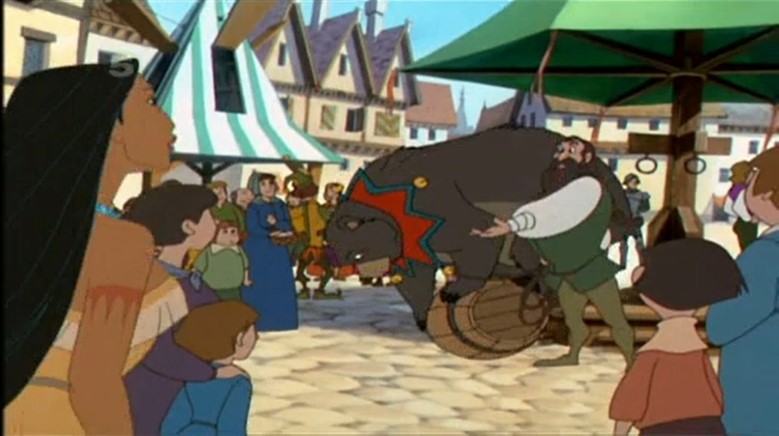
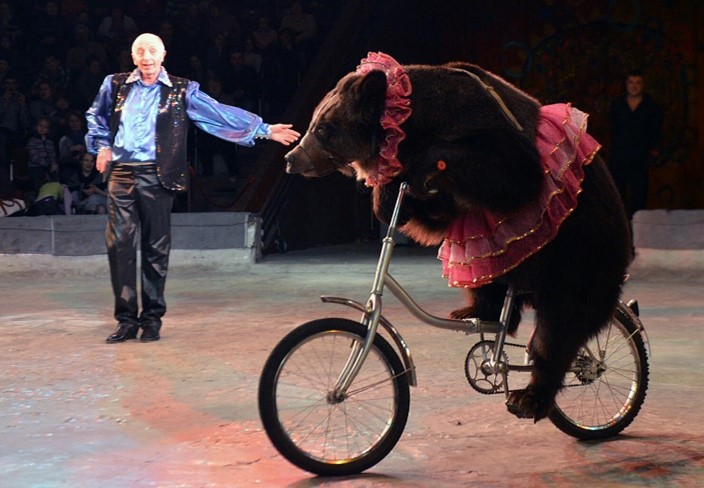
bear in figure 5 in terms of performance and costume
This introduces the human-animal relationship as owner-owned, commodifier-commodified and ultimately winner-loser as the owner benefits to the detriment of the animal. The next time that we meet the bear, they are caged by a hunchbacked, dodgy-looking guy who Ratcliffe pays to bring the bear to the Hunt Ball so that it can be tortured in a bearbaiting, which he knows will go down like a lead balloon with Pocahontas. This associates the commodifier with evil, portraying that evil benefits from both the abuse and commodification of animals and depicting this as immoral.
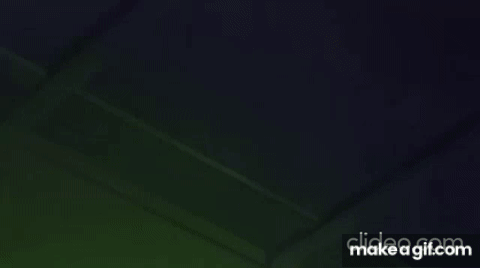
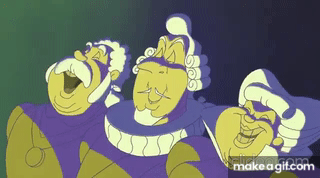
dehumanised
The bearbaiting goes down exactly as Ratcliffe planned as the torture of the bear freaks Pocahontas out and her anger provokes the King. This scene is formulated in a way which associates it with the horror genre. Creepy, grey-faced jesters stab the bear with pitchforks (off screen of course, this is a U). The pained roars of the bear can be heard amongst the hysterical laughing of the guests and jesters as dramatic music plays in the background. The sharp teeth of the bear are visible against the black silhouette of their body and chains. The guests are dehumanised as they are portrayed in a caricature style with distorted coloured skin as it turns yellow and purple. The Disney trope of the sickly green glow appears, something that has come to signify the presence of evil, as evidenced in figures 11 and 12. The combination of all of these elements creates an overwhelming sense of chaos. The elements of this scene ensure that we view the bearbaiting as horrific, in line with Pocahontas’ perception.
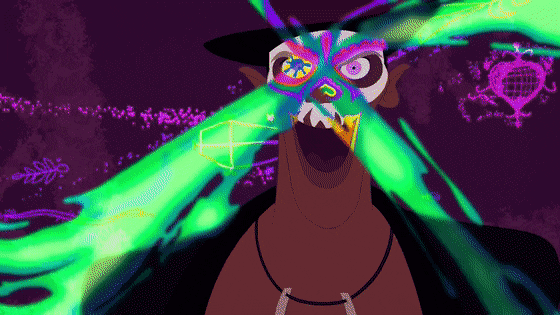
and the Frog
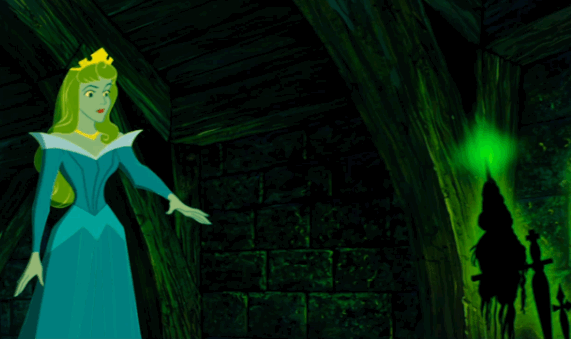
Beauty
Rolfe asks for this to stop but only as Pocahontas ‘doesn’t understand’, not because he sees anything wrong with a bear being tortured. The King represents his country and culture when he says, ‘Oh nonsense, everybody loves a good bearbaiting’. Whilst signifying the historical context of bearbaiting as being an accepted form of entertainment in Jacobean society, this also highlights how animal cruelty can hide behind cultural excuses or be blindly accepted when it becomes popular or ingrained in the social norm. A cultural outsider like Pocahontas can recognise this easily, as can the viewer as modern values generally align with her views of public spectacles of animal torture being abhorrent. The King later depreciates animals again as he says that ‘This is an animal. Nothing more’. This is most evidently referencing the bear, yet while he is talking, he wields the leg of meat he was eating in a threatening way and the camera follows this. Here, the King asserts his dominance over animals but the morality of this dominance comes into question as he reduces the value of the animal to product, even after being face to face with a suffering creature. Meat represents a social disconnect between animal suffering and human pleasure and drawing to attention to it in the context of a bearbaiting encourages the viewer to reflect on the widely accepted human use of animals for entertainment or pleasure in current times, such as animals performing in circuses or the consumption of meat.


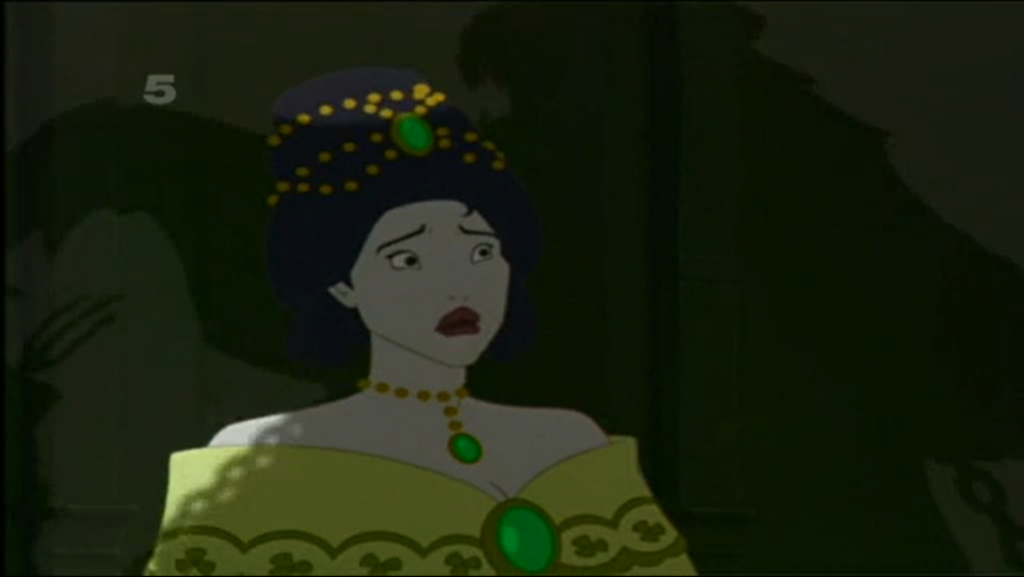
Whilst all of these aspects have valid applications to the treatment of animals, they also say something of the treatment of humans. Pocahontas and the bear connect and a new type of human-animal relationship is introduced as one of affinity. The bear’s shadow overlays Pocahontas’ horrified facial expression as it continues to be tortured. Their silhouettes overlap, visually linking them together. They are aligned with each other earlier than this too as the way in which the bear performs to an audience in the streets of London is similar to the way in which Pocahontas is viewed as she sings ‘What a Day in London’. They are both native to North America and find themselves a spectacle in a foreign city. It is important to note that it can be problematic to align animals with Pocahontas and Native American people given the context of the repeated accusations from the English that the Natives are savages. Comparing them to animals could reinforce such racism and misconception, going against the films own agenda by reducing Native Americans to ‘animalistic’.
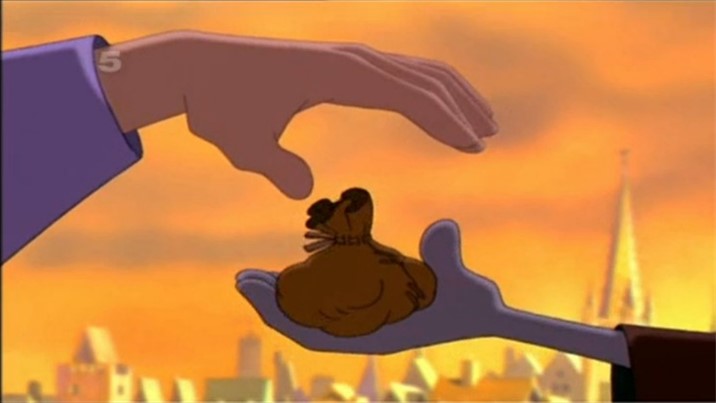
However, Paul Wells’ writing on the use of animals as national animal symbols offers insight on this. He writes that, ‘Animals become the effective short-cuts by which power and ideology might be grasped and understood by a mass audience, without the complications of the actual political conduct and conflict included’.[3] When applying this logic, the bear becomes not a comparison to but a representation of Native Americans as a cultural symbol. They qualify as such as they are native to North America and are recognised as being a part of Native American culture, portrayed in Pocahontas II in the snowy scene at the start of the film. The real colonial violence is omitted from Pocahontas’ story as Disney romanticises and moderates her life, avoiding the ‘complications’ referenced by Wells. However, the bears torture offers a representation of this violence. It is a portrayal of the brutality that the Native American people suffered at the hands of colonisers, particularly as Ratcliffe funded the torture of the bear and is the most violent coloniser in the movie. The mistreatment of the bear also symbolises the mistreatment of Native Americans in other ways. The aforementioned way in which bearbaiting is socially accepted and leaves abuse unchallenged reflects the cultural acceptance of racism and harmful stereotyping. The initial human-animal relationship of owner-owned or winner-loser represents a power imbalance in terms of the dominant, English colonisers capitalising on the American environment and culture. The horror-framed bearbaiting scene becomes one that draws attention to the atrocity of colonial violence and identifies the English perpetrators as villains. The symbol of the bear becomes a method through which the film can identify and portray human atrocities whilst still maintaining a family-friendly, (arguably) uncontroversial Disney appearance.

Pocahontas does stop the torture of the bear and eventually turn it around with the King and you would assume that in true Disney style, a happy ending would be had by all. Unfortunately, the fate of the bear is ambiguous. He is freed from his original owner and is adopted by Uttamatomakkin and Mrs. Jenkins, both ‘goodies’. However, the bear still has a rope around their neck, on which Jenkins pulls at after she comedically says, ‘And you, mind your manners’. The continued restriction of the bear by the English leaves the problem of animal exploitation unresolved, allowing the bear to transgress the linear limits of the film and become a symbol for modern animals which are exploited for human entertainment, such as those forced to perform in circuses or dance on streets. This restriction, along with Jenkins’ comments on the manners of the bear presents a colloquial and humorous attempt to subdue the inherent characteristics of the bear, symbolising the way in which the colonisation of Native American people is masked as something positive in the assimilation from ‘savageness’ to ‘civilisation’. Again, the way in which this problem is left unresolved lets the bear transgress the confines of the film and comments on the continuing undervaluation and mistreatment of Native American culture.
In conclusion, bears in Pocahontas II: Journey to a New World signify both a historical and modern unresolved conflict between humans and animals in terms of the commodification of animals for human entertainment to the detriment of the happiness, freedom and health of animals. Simultaneously, the bear is a vessel through which violence against the Native American people in and after colonial conflict is presented. The way in which the film concludes with the bear still under the constraints of the English, albeit a friendly English person, leaves this problem unresolved and portrays how these issues extend past both the universe of the film and the historical period in which the film is set.
Endnotes
[1] Desmond Morris, Peoplewatching (England: Vintage, 2002), p395.
[2] Paul Wells, The Animated Bestiary: Animals, Cartoons, and Culture (New Brunswick, New Jersey and London: Rutgers University Press, 2008), p77.
[3] Paul Wells, The Animated Bestiary: Animals, Cartoons, and Culture (New Brunswick, New Jersey and London: Rutgers University Press, 2008), p169.
Media Used
Fig 1 – HomeofUKVHSTrailers, Pocahontas 2: Journey To a New World UK VHS Trailer, online video recording, YouTube, 16 February 2022, <https://www.youtube.com/watch?v=vkXMJaZJoak> [accessed 16 January 2022]
Fig 2 – Uryadnikov, Sergey, Forename Brown bear with open mouth standing on his hind legs in winter, digital photograph, myloveview.com, no date found, <https://myloview.com/sticker-brown-bear-with-open-mouth-standing-on-his-hind-legs-in-winter-no-C6EEC92> [accessed 15 January 2022]
Fig 4 – Still from KAMCHATKA BEARS. LIFE BEGINS dir. Zhuravleva, Irina & Grishin, Vladislav, digital photograph, Institut Francais, 2018, <https://www.institut-francais.org.uk/cine-lumiere/whats-on/festivals-series/kamchatka-bears-life-begins/> [accessed 15 January 2022]
Fig 5 – iHeart A Performing Bear Has Had Enough of Being Dressed up Like a Jackass!, digital photograph, iHeart, 19 July 2021, <https://www.iheart.com/content/2021-07-19-a-performing-bear-has-had-enough-of-being-dressed-up-like-a-jackass/> [accessed 15 January 2022]
Fig 8 – Dr Chocolate232, Pocahontas 2 – Cobbing Bear, online video recording, YouTube, 9 January 2021, <https://www.youtube.com/watch?v=Wzp1aneF0bE> [accessed 16 January 2022]
Fig 12 – Clip from Clements, Ron and Musker John, dir., Princess and the Frog (Walt Disney Studios Motion Pictures, 2009)
Fig 13 – Clip from Geronimi, Clyde (Supervising), Clark, Les, Larson, Eric and Reitherman, Wolfgang, dir., Sleeping Beauty (Walt Disney Studios Motion Pictures, 1959)
Fig 14 – Alamy Bear-baiting with dogs in the 16th century, Digital image of artwork, Financial Times, no date found, <https://www.ft.com/content/e89c336a-81aa-11e6-bc52-0c7211ef3198> [accessed 17 January 2022]
Remaining figures – From Ellery, Tom and Raymond, Bradley, dir., Pocahontas II: Journey to a New World (Walt Disney Home Video, 1998)
Further Reading
Stanton, Rebecca Rose, The Disneyfication of Animals (United Kingdom: Palgrave Macmillan, 2020)
Tünaydin, Pelin, ‘Pawing through the History of Bear Dancing in Europe’ Frühneuzeit-Info, 24 (2013), pp. 51-60 <http://www.bearconservation.org.uk/Pawing_through_the_History_of_Bear_Danci.pdf>
Scott Warren, Jason ‘When Theaters Were Bear-Gardens; Or, What’s at Stake in the Comedy of Humors’ Shakespeare Quarterly, 54.1 (2003), pp. 63-82 <https://www.proquest.com/scholarly-journals/when-theaters-were-bear-gardens-whats-at-stake/docview/195886241/se-2?accountid=13828>
Regal Reel Blog, ‘Disney Villains and the Psychology of Color’, Regal Movies, 2019 <https://www.regmovies.com/static/en/us/blog/disney-villains-psychology-of-color#> [accessed 17 January 2022]